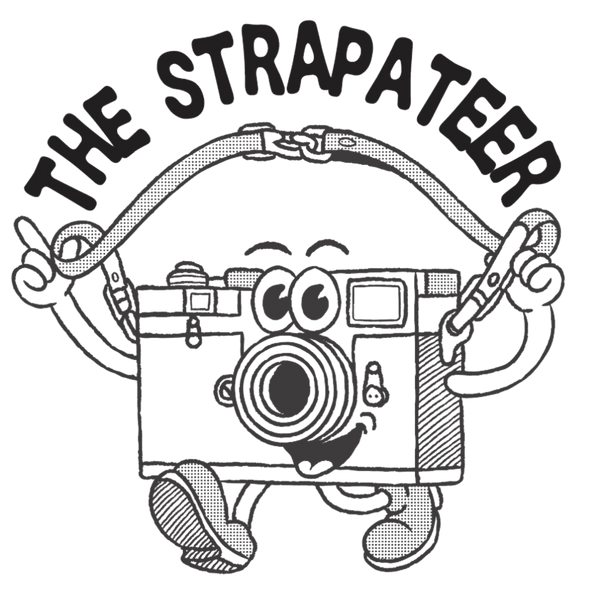Our Strapateer recreation is a tribute to the great photographers and photojournalists who taught the world to see - and to those who paid with their lives to bring images home from the frontline of history.

Henri Huet - Associated Press Vietnam
-----------------------
photojournalist Kent Potter in Vietnam
----------------------
Photojournalist Keizaburo Shimamoto
-----------------------
Photojournalist Larry Burrows
-----------------------
In 1971, the four photojournalists featured above; Larry Burrows, Kent Potter, Keisaburo Shimamoto and Henri Huet, climbed aboard a US Army helicopter and flew towards the Ho Chi MIn trail.
They would never return. Their helicopter was brought down by enemy fire. They had taken the greatest risks to bring back some of the most compelling images of the Vietnam war.
When their friend and fellow photographer, Horst Faas, searched years later for their remains, all that was found was Larry's Leica camera.
'To us younger men who had not yet earned reputations, he was a sainted figure. He was a truly beautiful man, modest, graceful, a star who never behaved like one. He was generous to all, a man who gave lessons to his colleagues not just on how to take photographs but, more important, on how to behave like a human being, how to be both colleague and mentor. Our experience of the star system in photography was, until we met him, not necessarily a happy one; all too often talent and ego seemed to come together in equal amounts. We were touched by Larry: How could someone so talented be so graceful?'
— David Halberstam, Requiem: By the Photographers Who Died in Vietnam and Indochina
-----------------------

Photojournalist Denis Cameron, New York Times correspondent Gloria Emerson, and Nguyen Ngoc Luong, interpreter, Saigon, South Vietnam, April 19th 1971. Photograph by Richard Avedon. In an interview with Avedon, Gloria reflected- "Did I talk to you about the time we went past a checkpoint and they opened fire? Denis and I were driving back because he had a girlfriend who’d come to see him in Phnom Penh and he was very upset because he thought a very smart English correspondent would take the girl away. I don’t know who he cared for most, the English correspondent who suddenly loomed up as a rival - but whom he adored as a friend - or the girl who was very decorative and rather a famous English debutante who’d come to Phnom Penh in the midst of all this war. We drove straight through a checkpoint and I was very cross. The Cambodians opened fire. The car turned over and Denis and our interpreter got out and started running to a rice paddy to hide. I was slower to follow and I got caught and I couldn’t find my handbag and the firing went on. Finally I got out of the car and thought, 'It is simply too late. I won’t catch up with them.' But Denis had waited. He’d crawled a few feet and turned around and waited for me to come. And he had his hand stretched out. That was so extraordinary. He had waited. He was furious I took so long but he had waited. We crawled a bit and sank into all this God-awful mud and Denis said something about, 'You had to go back for your fucking handbag!' His splendid noble moment was over. We shouted that we were Americans and the Cambodians stopped firing and said in French they were sorry; they hoped we would forget the little incident. But I never forgot it. Because Denis had waited. Not many people wait for many people, do they? I think one of the great things that you can see someone do is reaching out literally to save you. To show you the way. I’ll never forget his hand stretched out to me. That may be love. I don’t know. Then, again, it might be better than love, don’t you think?
----------------------------
War and portrait photographer Marie-Laure de Decker
She said - “Colour is never as beautiful as in real life, so it’s in black and white that people’s souls show,”
-----------------------------

Eddie Adams - associated press photographer and Pulitzer prize winner
----------------------
Pulitzer prize winning photographer Kyoichi Sawada
---------------------------
Akihiko Okamuro
-------------------------
Elliot Erwitt
------------------------

The legendary Gordon Parks - “I saw that the camera could be a weapon against poverty, against racism, against all sorts of social wrongs. I knew at that point I had to have a camera.”
-------------------------


Bob Schwalberg, photojournalist, writer and inventor (in 1957) of 'The Strapateer' portrait photograph by Phillip Leonian circa 1982
--------------------------

Havana 1959, Magnum photographer Burt Glinn
---------------------------

Photojournalist Lee Lockwood with Castro in Havana 1964
-------------------------

Life magazine photographer, Paul Schutzer
-------------------------

Photojournalist Mary Ellen Mark with Marlon Brando on the set of 'Apocalypse Now'
--------------------------

Photojournalist, Steve Schapiro
---------------------------

LIFE photographer John Shearer

----------------------------


Rock and Roll photojournalist Jim Marshall
-----------------------------

Rock and Roll photojournalist, David Gahr - 1971
-----------------------------

The legendary Nikon F at rest at during the Vietnam war.
-------------------




























